TFE3, a potential therapeutic target for Spinal Cord Injury via augmenting autophagy flux and alleviating ER stress
- PMID: 32802192
- PMCID: PMC7415792
- DOI: 10.7150/thno.46566
TFE3, a potential therapeutic target for Spinal Cord Injury via augmenting autophagy flux and alleviating ER stress
Abstract
Background and Aim: Increasing evidence suggests that spinal cord injury (SCI)-induced defects in autophagic flux may contribute to an impaired ability for neurological repair following injury. Transcription factor E3 (TFE3) plays a crucial role in oxidative metabolism, lysosomal homeostasis, and autophagy induction. Here, we investigated the role of TFE3 in modulating autophagy following SCI and explored its impact on neurological recovery. Methods: Histological analysis via HE, Nissl and Mason staining, survival rate analysis, and behavioral testing via BMS and footprint analysis were used to determine functional recovery after SCI. Quantitative real-time polymerase chain reaction, Western blotting, immunofluorescence, TUNEL staining, enzyme-linked immunosorbent assays, and immunoprecipitation were applied to examine levels of autophagy flux, ER-stress-induced apoptosis, oxidative stress, and AMPK related signaling pathways. In vitro studies using PC12 cells were performed to discern the relationship between ROS accumulation and autophagy flux blockade. Results: Our results showed that in SCI, defects in autophagy flux contributes to ER stress, leading to neuronal death. Furthermore, SCI enhances the production of reactive oxygen species (ROS) that induce lysosomal dysfunction to impair autophagy flux. We also showed that TFE3 levels are inversely correlated with ROS levels, and increased TFE3 levels can lead to improved outcomes. Finally, we showed that activation of TFE3 after SCI is partly regulated by AMPK-mTOR and AMPK-SKP2-CARM1 signaling pathways. Conclusions: TFE3 is an important regulator in ROS-mediated autophagy dysfunction following SCI, and TFE3 may serve as a promising target for developing treatments for SCI.
Keywords: AMPK signaling pathways; Autophagy; ER stress-induced apoptosis; Spinal cord injury; TFE3.
© The author(s).
Conflict of interest statement
Competing Interests: The authors have declared that no competing interest exists.
Figures
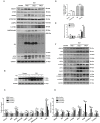
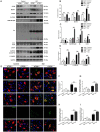
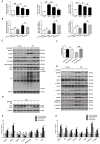
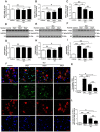
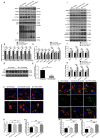
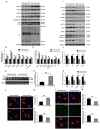
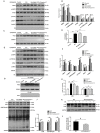
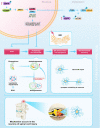
Similar articles
-
Bone marrow mesenchymal stem cells modulate miR-202-3p to suppress neuronal apoptosis following spinal cord injury through autophagy activation via the AMPK, MAPK, and PI3K/AKT/mTOR signaling pathway.Sci Rep. 2024 Dec 3;14(1):30099. doi: 10.1038/s41598-024-81332-y. Sci Rep. 2024. PMID: 39627300 Free PMC article.
-
Metformin Improves Functional Recovery After Spinal Cord Injury via Autophagy Flux Stimulation.Mol Neurobiol. 2017 Jul;54(5):3327-3341. doi: 10.1007/s12035-016-9895-1. Epub 2016 May 11. Mol Neurobiol. 2017. PMID: 27167128
-
Betulinic acid inhibits pyroptosis in spinal cord injury by augmenting autophagy via the AMPK-mTOR-TFEB signaling pathway.Int J Biol Sci. 2021 Mar 11;17(4):1138-1152. doi: 10.7150/ijbs.57825. eCollection 2021. Int J Biol Sci. 2021. PMID: 33867836 Free PMC article.
-
The Temporal Pattern, Flux, and Function of Autophagy in Spinal Cord Injury.Int J Mol Sci. 2017 Feb 21;18(2):466. doi: 10.3390/ijms18020466. Int J Mol Sci. 2017. PMID: 28230791 Free PMC article. Review.
-
ROS: Executioner of regulating cell death in spinal cord injury.Front Immunol. 2024 Jan 23;15:1330678. doi: 10.3389/fimmu.2024.1330678. eCollection 2024. Front Immunol. 2024. PMID: 38322262 Free PMC article. Review.
Cited by
-
Ginsenoside Rb1 improves energy metabolism after spinal cord injury.Neural Regen Res. 2023 Jun;18(6):1332-1338. doi: 10.4103/1673-5374.357915. Neural Regen Res. 2023. PMID: 36453420 Free PMC article.
-
Trehalose delays postmenopausal osteoporosis by enhancing AKT/TFEB pathway‑dependent autophagy flow in rats.Exp Ther Med. 2023 Oct 2;26(5):538. doi: 10.3892/etm.2023.12237. eCollection 2023 Nov. Exp Ther Med. 2023. PMID: 37869632 Free PMC article.
-
Research trends on acupuncture for neuropathic pain: A bibliometric analysis from 1979 to 2023.Medicine (Baltimore). 2024 May 3;103(18):e37962. doi: 10.1097/MD.0000000000037962. Medicine (Baltimore). 2024. PMID: 38701301 Free PMC article.
-
Bone marrow mesenchymal stem cells modulate miR-202-3p to suppress neuronal apoptosis following spinal cord injury through autophagy activation via the AMPK, MAPK, and PI3K/AKT/mTOR signaling pathway.Sci Rep. 2024 Dec 3;14(1):30099. doi: 10.1038/s41598-024-81332-y. Sci Rep. 2024. PMID: 39627300 Free PMC article.
-
TFE3-mediated neuroprotection: Clearance of aggregated α-synuclein and accumulated mitochondria in the AAV-α-synuclein model of Parkinson's disease.Genes Dis. 2024 Sep 7;12(2):101429. doi: 10.1016/j.gendis.2024.101429. eCollection 2025 Mar. Genes Dis. 2024. PMID: 39759118 Free PMC article.
References
-
- Badhiwala JH, Wilson JR, Fehlings MG. Global burden of traumatic brain and spinal cord injury. Lancet Neurol. 2019;18:24–25. - PubMed
-
- Beattie MS, Hermann GE, Rogers RC, Bresnahan JC. Cell death in models of spinal cord injury. Prog Brain Res. 2002;137:37–47. - PubMed
-
- Tator CH. Experimental and clinical studies of the pathophysiology and management of acute spinal cord injury. J Spinal Cord Med. 1996;19:206–14. - PubMed
Publication types
MeSH terms
Substances
LinkOut - more resources
Full Text Sources
Medical
Molecular Biology Databases
Miscellaneous

